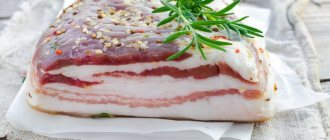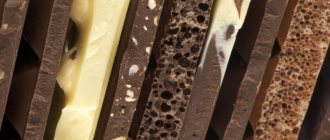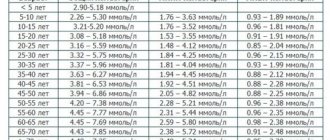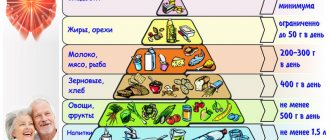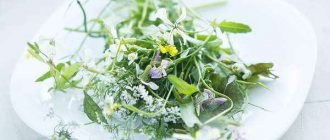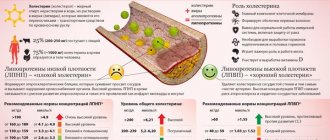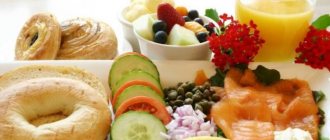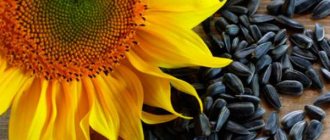General rules
Elevated blood cholesterol for atherosclerosis .
This fat-like substance is necessary for the formation of enzymes , hormones and other things. However, when its metabolism is disrupted and its level in the blood is high, irreversible changes develop in the wall of blood vessels - atherosclerosis, which is dangerous for its complications ( heart attack , stroke , disruption of the blood supply to various organs).
Dangerous in terms of the development of atherosclerosis is considered to be an imbalance between fractions - low-density lipoproteins LDL and high-density lipoproteins (HDL). The former have an atherogenic effect and their high content is a risk of cardiovascular diseases. High-density (“good”) cholesterol is produced by the body. Moderate physical activity promotes its production and at the same time reduces the accumulation of harmful substances, which only comes from foods.
Nutritional therapy has been developed to reduce cholesterol levels. A diet for lowering blood cholesterol levels can be used in the treatment and prevention of diseases - it is suitable for people who monitor their health. Its goal is to improve lipid metabolism and weight loss. The main principle of this diet is the reduction of animal fat, which we get from meat, fatty dairy products, and simple carbohydrates. Polyunsaturated fats (their sources are vegetable oils and nuts), fiber and complex carbohydrates (we get them from vegetables, grains, bran) should predominate in the diet. It is the large amount of fiber that helps remove excess cholesterol from the gastrointestinal tract. The protein content in this therapeutic diet is within normal limits, and can be obtained by consuming a variety of legumes and lean meats.
The amount of bread is no more than 200 g per day; the use of dietary bran bread is also allowed. Salt and the amount of liquid consumed are limited to 1.2 liters. Dishes must be prepared without salt, but it is allowed to add salt to prepared food on the table. Vegetables are eaten raw or stewed, and it is better to boil (bake) meat and fish to reduce fat in the diet. It is important to eat plenty of vegetables at dinner. Daily calorie content is 1400-1500 kcal.
Basic principles of nutrition for high blood cholesterol:
- Grains, vegetables and fruits, containing complex carbohydrates and high amounts of fiber, should make up about 60% of the diet. You need to eat 400 g of vegetables daily (one third fresh) and 200 g of grain products.
- The predominance of vegetable oils in the diet.
- Moderate consumption of permitted dairy products.
- Diet for high blood cholesterol includes fish, chicken and turkey, which are the foods of choice, and lean beef should take second place in the diet.
- The amount of salt is minimal.
- 2-3 eggs per week (unlimited protein).
- Avoid feeling hungry (have fruit snacks on time).
The diet for high cholesterol in women is no different from that for men and the general principles of nutrition remain the same. Total cholesterol in women and men should be no more than 5.2 mmol/l; a figure of 6.19 mmol/l is already considered significantly increased. HDL in women should be at least 0.9 mmol/l and up to 1.9 mmol/l; in men this figure is different - from 0.7 to 1.7 mmol/l.
The onset of menopause has an adverse effect on cholesterol metabolism and is explained by the fact that with the onset of menopause, estrogen decreases, and it regulates the production of “good” cholesterol. The increase in “bad” is facilitated by a woman’s sedentary lifestyle, overeating and consumption of fatty and high-calorie foods.
Diet for women with high cholesterol should contain as much as possible plant foods rich in phytosterols , which control and reduce the level of bad cholesterol:
- wheat germ;
- sesame seeds;
- sunflower seeds;
- flax seed;
- olive oil;
- grape seed oil;
- avocado.
Vegetables and fruits containing pectin : apples, citrus fruits, beets, watermelons and natural vegetable juices. Remember that all purple and red fruits and vegetables contain polyphenols that stimulate the production of good cholesterol: blueberries, strawberries, raspberries, cranberries, cranberry juice, chokeberries, lingonberries, pomegranate, purple and red grapes, plums, eggplants. Green leafy salads and vegetables are also useful: cabbage, lettuce, spinach, sorrel, artichoke and parsley, dill and green onions available to everyone.
It is imperative to include legumes in your diet, which, due to their high fiber content, will remove harmful cholesterol from the intestines. In terms of protein content, they can replace meat.
It is beneficial for older women to consume soy products containing phytoestrogens . Do not forget about proper culinary processing of meat and fish - a minimum of fat when cooking - it is best to bake in the oven, in pots or steamed.
Considering women's craving for sweets, it will be very difficult to give up sweet cream products, chocolate and sweets, pastries, cookies, waffles and limit yourself in sugar. But this must be done. Fatty meat should also disappear from the diet; you will have to give up processed meat (sausage, boiled pork). Pork, lard and bacon are prohibited. Don't forget about the need for physical activity. All this will only bring benefits - your tests will normalize, your weight will drop, and you will consider yourself attractive.
Often, high cholesterol is observed in diseases of the internal organs and endocrine system: nephritis , hypothyroidism , obesity , diabetes mellitus . This combined pathology requires a special approach to nutrition and more serious treatment. In each case, the issue is resolved individually and therapeutic nutrition is prescribed for the underlying disease. For example, what diet is indicated for high cholesterol due to kidney disease? In this case, you need to follow Table No. 7 and its variations. Diet 7 is prescribed for chronic kidney disease and, in addition to limiting salt and the amount of liquid you drink, it involves excluding foods rich in cholesterol (kidneys, liver, egg yolks, brains).
Nutritional features for hypercholesterolemia
- Fractional meals. The basic principle is to eat even when you don’t feel like it, but in small portions (100-200 g), 5-6 times a day.
- Ease of preparation. If you have high cholesterol, fried, smoked, pickled foods, and any preserves are strictly prohibited.
- Breakfast. Should consist of carbohydrates - porridge cooked in water or low-fat milk.
- Dinner. Must include soup or broth and hot dishes, for example, boiled fish or meat with a side dish.
- Dinner. Preference should be given to salads, vegetables with fish or meat.
- Lunch and afternoon tea. Fruit salads, fruits, fresh vegetables, dried fruits, nuts, and dairy products are ideal as snacks.
- 1 hour before bedtime, it is recommended to drink a glass of kefir, natural yogurt or freshly prepared vegetable juice.
- You need to drink about 1-1.5 liters of water per day. You cannot replace it with tea, compotes, or herbal decoctions.
- It is very important to reduce your consumption of animal fats by at least a third.
- It is advisable to completely give up coffee. Or drink no more than 1 cup a day of a brewed natural drink. Ginger tea has a good tonic effect. This is a good alternative to invigorating, but harmful coffee for high cholesterol.
When preparing a diet, women are advised to include more soy products containing phytoestrogens in the menu, consume sprouted wheat grains more often, and drink more natural juices. It is advisable to reduce sugar consumption and move more.
Men should carefully monitor their protein intake, eat more legumes and fish, give up salt or limit its amount to 8 g per day. Along with proper nutrition, it is advisable to completely give up bad habits (smoking, alcoholic drinks).
Very often, hypercholesterolemia is combined with pathologies of internal organs: high blood sugar, disturbances in the functioning of the thyroid gland, liver, and kidneys. This situation requires a special approach.
Authorized Products
Proper nutrition for high cholesterol should become the norm. What should it be? First of all, you need to exclude meat broths - prepare vegetarian soups; if this is difficult and unusual for you, then you can use weak secondary broth for first courses and carefully skim off the fat. Use potatoes in minimal quantities and it is better to prepare combined vegetable soups, cabbage soup and borscht.
Meat and poultry should be taken of lean types; poultry skin is unacceptable; additional fat should be trimmed from the meat. Since the diet involves limiting fat, the meat should be boiled or baked without adding sour cream, mayonnaise or any fat. Use vegetables as a side dish, not cereal. It is better to cook them for breakfast (oatmeal, buckwheat and brown rice).
Cabbage (all types), carrots, zucchini, pumpkin, eggplant, or salads made from fresh vegetables and green peas will help lower cholesterol levels. The total amount of vegetables eaten per day is at least 400g.
Use virgin vegetable oils to season ready-made dishes. omega-3 fatty acids, which regulate the production of beneficial lipids, is useful in this regard .
Lowering cholesterol levels can be achieved by introducing low-fat sea fish into the diet, but the consumption of meat (chicken) should still be limited to once a week. When it comes to fish, you should choose dietary varieties: hake, haddock, blue whiting, navaga, pollock, pollock.
Bread made from rye, grain flour and bran is allowed. You can use yeast-free bread (with bran, with flax seeds) for snacks and first courses. Milk and fermented milk products are allowed only in low fat content and in limited quantities. Green tea and weak coffee with milk and without sugar, vegetable and fruit juices without sugar are allowed.
Table of permitted products
| Proteins, g | Fats, g | Carbohydrates, g | Calories, kcal | |
Vegetables and greens | ||||
| eggplant | 1,2 | 0,1 | 4,5 | 24 |
| beans | 6,0 | 0,1 | 8,5 | 57 |
| zucchini | 0,6 | 0,3 | 4,6 | 24 |
| cabbage | 1,8 | 0,1 | 4,7 | 27 |
| broccoli | 3,0 | 0,4 | 5,2 | 28 |
| Brussels sprouts | 4,8 | 0,0 | 8,0 | 43 |
| cauliflower | 2,5 | 0,3 | 5,4 | 30 |
| green onion | 1,3 | 0,0 | 4,6 | 19 |
| bulb onions | 1,4 | 0,0 | 10,4 | 41 |
| carrot | 1,3 | 0,1 | 6,9 | 32 |
| cucumbers | 0,8 | 0,1 | 2,8 | 15 |
| squash | 0,6 | 0,1 | 4,3 | 19 |
| salad pepper | 1,3 | 0,0 | 5,3 | 27 |
| parsley | 3,7 | 0,4 | 7,6 | 47 |
| salad | 1,2 | 0,3 | 1,3 | 12 |
| beet | 1,5 | 0,1 | 8,8 | 40 |
| celery | 0,9 | 0,1 | 2,1 | 12 |
| soybeans | 34,9 | 17,3 | 17,3 | 381 |
| asparagus | 1,9 | 0,1 | 3,1 | 20 |
| tomatoes | 0,6 | 0,2 | 4,2 | 20 |
| Jerusalem artichoke | 2,1 | 0,1 | 12,8 | 61 |
| pumpkin | 1,3 | 0,3 | 7,7 | 28 |
| dill | 2,5 | 0,5 | 6,3 | 38 |
| beans | 7,8 | 0,5 | 21,5 | 123 |
| garlic | 6,5 | 0,5 | 29,9 | 143 |
| lentils | 24,0 | 1,5 | 42,7 | 284 |
Fruits | ||||
| avocado | 2,0 | 20,0 | 7,4 | 208 |
| oranges | 0,9 | 0,2 | 8,1 | 36 |
| pomegranate | 0,9 | 0,0 | 13,9 | 52 |
| grapefruit | 0,7 | 0,2 | 6,5 | 29 |
| pears | 0,4 | 0,3 | 10,9 | 42 |
| lemons | 0,9 | 0,1 | 3,0 | 16 |
| mango | 0,5 | 0,3 | 11,5 | 67 |
| tangerines | 0,8 | 0,2 | 7,5 | 33 |
| nectarine | 0,9 | 0,2 | 11,8 | 48 |
| peaches | 0,9 | 0,1 | 11,3 | 46 |
| apples | 0,4 | 0,4 | 9,8 | 47 |
Berries | ||||
| gooseberry | 0,7 | 0,2 | 12,0 | 43 |
| Red currants | 0,6 | 0,2 | 7,7 | 43 |
| black currant | 1,0 | 0,4 | 7,3 | 44 |
Nuts and dried fruits | ||||
| nuts | 15,0 | 40,0 | 20,0 | 500 |
| almond | 18,6 | 57,7 | 16,2 | 645 |
| flax seeds | 18,3 | 42,2 | 28,9 | 534 |
| fenugreek seeds | 23,0 | 6,4 | 58,3 | 323 |
| sunflower seeds | 20,7 | 52,9 | 3,4 | 578 |
Cereals and porridges | ||||
| buckwheat (kernel) | 12,6 | 3,3 | 62,1 | 313 |
| oat groats | 12,3 | 6,1 | 59,5 | 342 |
| cereals | 11,9 | 7,2 | 69,3 | 366 |
| wheat bran | 15,1 | 3,8 | 53,6 | 296 |
Raw materials and seasonings | ||||
| basil | 2,5 | 0,6 | 4,3 | 27 |
| honey | 0,8 | 0,0 | 81,5 | 329 |
Dairy | ||||
| kefir 0% | 3,0 | 0,1 | 3,8 | 30 |
| kefir 1% | 2,8 | 1,0 | 4,0 | 40 |
Cheeses and cottage cheese | ||||
| cottage cheese 0.6% (low fat) | 18,0 | 0,6 | 1,8 | 88 |
| curd tofu | 8,1 | 4,2 | 0,6 | 73 |
Meat products | ||||
| beef | 18,9 | 19,4 | 0,0 | 187 |
Bird | ||||
| chicken fillet | 23,1 | 1,2 | 0,0 | 110 |
| turkey | 19,2 | 0,7 | 0,0 | 84 |
Eggs | ||||
| eggs | 12,7 | 10,9 | 0,7 | 157 |
Fish and seafood | ||||
| fish | 18,5 | 4,9 | 0,0 | 136 |
| seaweed | 0,8 | 5,1 | 0,0 | 49 |
Oils and fats | ||||
| grape seed oil | 0,0 | 99,9 | 0,0 | 899 |
| linseed oil | 0,0 | 99,8 | 0,0 | 898 |
| olive oil | 0,0 | 99,8 | 0,0 | 898 |
| sunflower oil | 0,0 | 99,9 | 0,0 | 899 |
Non-alcoholic drinks | ||||
| mineral water | 0,0 | 0,0 | 0,0 | — |
| instant chicory | 0,1 | 0,0 | 2,8 | 11 |
| green tea | 0,0 | 0,0 | 0,0 | — |
| * data is per 100 g of product | ||||
The benefits of fish for patients with atherosclerosis
All types of fish contain cholesterol, but here's a paradox: fatty varieties of salmon and some white fish contain less cholesterol than ordinary white inhabitants of the seas such as mackerel. The benefits of any fish are great for the health of both healthy and sick people.
The value of marine life is higher than that of freshwater. Here's why you should eat fish if you have high cholesterol:
- It contains a lot of protein and amino acids, it is necessary to eat it for the correct course of all processes. Since meat is practically excluded from the diet, and the content of useful substances in industrial chicken is extremely doubtful, fish becomes the best alternative. Fillet is digestible by at least 95% and is digested several times faster than meat.
- Fat, represented by polyunsaturated fatty acids, stimulates the production of beneficial fatty substances in the liver, which cleanse the blood and blood vessels of bad cholesterol. With regular consumption of fish, the risk of developing ischemia is significantly lower.
- Phosphorus and other cholesterol essential microelements, including iodine and bromine, are important for metabolic processes and heart health.
- The vitamins included in any fish improve blood health, vision, normalize metabolic processes and prolong life. Sea inhabitants are rich in vitamin E, which is important for the process of lowering cholesterol.
But is every sea creature so healthy? Is there a critical level of cholesterol in fish, and what kind is undesirable to eat if you have atherosclerosis?
Fully or partially limited products
Excluded: pork, cooking fats, refined vegetable oil, margarine, butter, duck and goose meat, offal (kidneys, brains, liver), sausages and smoked meats. Fatty fish, fish roe (contains a large amount of cholesterol), crayfish, shrimp, crabs and any canned fish, including cod liver, are prohibited.
You should not consume puff pastry and pastry products, highly extractive meat, fish, or mushroom broths. Cream, fatty cottage cheese and sour cream are not allowed in the diet. Prohibition of consumption of chocolate, full-fat ice cream, products with cream and products with palm and coconut oil. Mayonnaise and ketchup should not be used as sauces.
Limit:
- beef (1-2 times a week);
- red fish;
- egg yolks;
- potato;
- fatty cheeses;
- nuts;
- buckwheat;
- honey.
Table of prohibited products
| Proteins, g | Fats, g | Carbohydrates, g | Calories, kcal | |
Fruits | ||||
| bananas | 1,5 | 0,2 | 21,8 | 95 |
Nuts and dried fruits | ||||
| raisin | 2,9 | 0,6 | 66,0 | 264 |
Cereals and porridges | ||||
| semolina | 10,3 | 1,0 | 73,3 | 328 |
| white rice | 6,7 | 0,7 | 78,9 | 344 |
Flour and pasta | ||||
| pasta | 10,4 | 1,1 | 69,7 | 337 |
Bakery products | ||||
| bagels | 16,0 | 1,0 | 70,0 | 336 |
| bagels | 16,0 | 1,0 | 70,0 | 336 |
| crackers | 11,2 | 1,4 | 72,2 | 331 |
Confectionery | ||||
| jam | 0,3 | 0,2 | 63,0 | 263 |
| jam | 0,3 | 0,1 | 56,0 | 238 |
| candies | 4,3 | 19,8 | 67,5 | 453 |
| pastry cream | 0,2 | 26,0 | 16,5 | 300 |
Ice cream | ||||
| ice cream | 3,7 | 6,9 | 22,1 | 189 |
Cakes | ||||
| cake | 4,4 | 23,4 | 45,2 | 407 |
Chocolate | ||||
| chocolate | 5,4 | 35,3 | 56,5 | 544 |
Raw materials and seasonings | ||||
| ketchup | 1,8 | 1,0 | 22,2 | 93 |
| mayonnaise | 2,4 | 67,0 | 3,9 | 627 |
Dairy | ||||
| cream | 2,8 | 20,0 | 3,7 | 205 |
| sour cream 30% | 2,4 | 30,0 | 3,1 | 294 |
| sour cream 40% (fat) | 2,4 | 40,0 | 2,6 | 381 |
Cheeses and cottage cheese | ||||
| cheese | 24,1 | 29,5 | 0,3 | 363 |
| cottage cheese 18% (fat) | 14,0 | 18,0 | 2,8 | 232 |
Meat products | ||||
| pork | 16,0 | 21,6 | 0,0 | 259 |
| pork liver | 18,8 | 3,6 | 0,0 | 108 |
| pork kidneys | 13,0 | 3,1 | 0,0 | 80 |
| pork fat | 1,4 | 92,8 | 0,0 | 841 |
| salo | 2,4 | 89,0 | 0,0 | 797 |
| beef liver | 17,4 | 3,1 | 0,0 | 98 |
| beef kidneys | 12,5 | 1,8 | 0,0 | 66 |
| beef brains | 9,5 | 9,5 | 0,0 | 124 |
| mutton | 15,6 | 16,3 | 0,0 | 209 |
Sausages | ||||
| smoked sausage | 16,2 | 44,6 | 0,0 | 466 |
| smoked sausage | 9,9 | 63,2 | 0,3 | 608 |
| sausages | 10,1 | 31,6 | 1,9 | 332 |
| sausages | 12,3 | 25,3 | 0,0 | 277 |
Bird | ||||
| smoked chicken | 27,5 | 8,2 | 0,0 | 184 |
| duck | 16,5 | 61,2 | 0,0 | 346 |
| smoked duck | 19,0 | 28,4 | 0,0 | 337 |
| goose | 16,1 | 33,3 | 0,0 | 364 |
Fish and seafood | ||||
| smoked fish | 26,8 | 9,9 | 0,0 | 196 |
| salted fish | 19,2 | 2,0 | 0,0 | 190 |
| Red caviar | 32,0 | 15,0 | 0,0 | 263 |
| black caviar | 28,0 | 9,7 | 0,0 | 203 |
| squid | 21,2 | 2,8 | 2,0 | 122 |
| shrimps | 22,0 | 1,0 | 0,0 | 97 |
| salmon | 19,8 | 6,3 | 0,0 | 142 |
| sturgeon | 16,4 | 10,9 | 0,0 | 163 |
| canned fish | 17,5 | 2,0 | 0,0 | 88 |
| semi-finished fish products | 12,5 | 6,7 | 14,7 | 209 |
| sardine | 20,6 | 9,6 | — | 169 |
| mackerel | 18,0 | 13,2 | 0,0 | 191 |
| cod (liver in oil) | 4,2 | 65,7 | 1,2 | 613 |
| boiled oysters | 14,0 | 3,0 | — | 95 |
| fresh oysters | 14,0 | 6,0 | 0,3 | 95 |
Oils and fats | ||||
| butter | 0,5 | 82,5 | 0,8 | 748 |
| creamy margarine | 0,5 | 82,0 | 0,0 | 745 |
| coconut oil | 0,0 | 99,9 | 0,0 | 899 |
| palm oil | 0,0 | 99,9 | 0,0 | 899 |
| rendered beef fat | 0,0 | 99,7 | 0,0 | 897 |
| cooking fat | 0,0 | 99,7 | 0,0 | 897 |
| rendered pork fat | 0,0 | 99,6 | 0,0 | 896 |
Non-alcoholic drinks | ||||
| cola | 0,0 | 0,0 | 10,4 | 42 |
| lemonade | 0,0 | 0,0 | 6,4 | 26 |
| Pepsi | 0,0 | 0,0 | 8,7 | 38 |
| sprite | 0,1 | 0,0 | 7,0 | 29 |
| * data is per 100 g of product | ||||
Cholesterol content in different types
The amount of cholesterol in seafood depends on its fat content, but one fact must be taken into account: the cholesterol in fish that lives in fresh water is very different from the substance found in marine life.
The fatty enzyme in freshwater fish is more reminiscent of bird fat in composition, but sea fat has a healthy formula.
The cholesterol content in different varieties can differ by 10 times, the amount is indicated per 100 g of fillet:
- Cod – 30 mg;
- Pike – 50 mg;
- Tongue – 60 mg;
- Trout – about 56 mg;
- Salmon – 70 mg;
- Herring – 97 mg;
- Pollock – 110 mg;
- Notothenia – 210 mg;
- Carp – 270 mg;
- Mackerel – 360 mg.
Menu (Power Mode)
The cholesterol diet menu is designed for 5 meals a day. Since you should not allow yourself to feel hungry during the day or in the evening, you are allowed to eat an apple, grapefruit, carrots or drink a fermented milk product. A sample menu for several days might look like this:
First option
| Breakfast |
|
| Lunch |
|
| Dinner |
|
| Afternoon snack |
|
| Dinner |
|
Second option
| Breakfast |
|
| Lunch |
|
| Dinner |
|
| Afternoon snack |
|
| Dinner |
|
Third option
| Breakfast |
|
| Lunch |
|
| Dinner |
|
| Afternoon snack |
|
| Dinner |
|
Below is a table of low cholesterol from which you can make up your diet.
| Products name | Featured | Prohibited |
| Fish | Lean sea fish (hake, blue whiting, pollock, navaga, pollock, haddock) and pike three times a week. | Salmon, mackerel, sardine, eel, mackerel, herring, oysters, caviar, shrimp, prepared fish, river fish in limited quantities. |
| Eggs | Up to 3 pieces per week. | Egg yolk. |
| Fats | Sunflower, corn, olive or soybean oils, up to 2 tablespoons per day. | Lard, margarine, palm and coconut oil, butter, animal fat. |
| Meat | Veal, rabbit, turkey, chicken, lean beef once or twice a week. The bird is allowed without skin. | Pork, fatty beef, fatty lamb, duck and goose meat, sausages, liver, kidneys, brain pates, sausages, sausages. |
| Dairy | Skim milk, low-fat kefir, yogurt, cheeses up to 20%, low-fat cottage cheese. | Full-fat cottage cheese, sour cream, cream, ice cream, curd mass, condensed milk, processed cheese. |
| Vegetables | Fresh and frozen, corn and beans. | Potatoes and potato snacks. |
| Fruits | Everything except banana and grapes, as well as dried fruits. | Sugared fruits, pistachios and peanuts, hazelnuts. |
| Cereals | Whole grain bread, brown rice, oatmeal, whole grain pasta. | White rice, semolina, limit buckwheat. |
| Bakery | Oatmeal cookies, bread rolls, dry cookies, “Fitness” cookies. | Biscuits, pastries, rolls, cakes, puff pastry products. |
| Sweets | Low-fat puddings, jellies without added sugar, fruit ice cream. | Chocolate, pastry cream, toffee, marmalade, pastille, sugar, syrups. |
| Beverages | Sugar-free juices, green tea, weak coffee, still mineral water. | Cocoa with milk, coffee with cream, alcoholic and sweet carbonated drinks. |
Balanced diet
For the full functioning of systems and organs, the human body must receive proteins, fats and carbohydrates from food every day. Therefore, even with a high concentration of cholesterol in the blood, it is impossible to completely abandon animal fats.
Proteins (proteins)
They are high molecular weight organic substances. Consist of alpha acids.
The greatest amount of protein is contained:
- lean veal;
- chicken breast;
- shrimps;
- sea fish;
- legumes
When planning your diet, it is important to consider that some of these foods contain high amounts of cholesterol. For example, shrimp or veal. Therefore, they can be included in the menu no more than 2 times a week.
Fats
Fats are a source of energy for the body. If you have high cholesterol, avoid saturated fats, which can increase levels of harmful LDL.
Preference should be given to vegetable, unsaturated fats, which are found in the following products:
- vegetable oils;
- nuts;
- dairy, fermented milk products.
Sea fish deserves special attention. It contains a lot of cholesterol, but it is not dangerous because its harmful effects are neutralized by unsaturated fatty acids. Therefore, in addition to vegetables and fruits, sea fish is an essential element of nutrition. It can be added to the menu every day.
Carbohydrates
Carbohydrates are simple and complex sugars, a source of energy, building material for cells. Their deficiency immediately affects the state of the body: the functioning of the cardiovascular system is disrupted, the metabolic rate drops, and the condition of the nervous system worsens.
The largest amount of carbohydrates is contained:
- whole wheat bread;
- vegetables fruits;
- legumes;
- whole grains;
- low-fat dairy products.
It is important to know that there is a separate group of carbohydrates called refined. They do not replenish the lack of energy in the body, but rather completely deplete the energy supply. Refined carbohydrates are easily digested.
They are developed artificially, therefore they are completely devoid of useful qualities. When there is an excess of them, they begin to quickly turn into fats. The diet completely excludes foods containing refined carbohydrates. These include confectionery, baked goods, sweets, and carbonated drinks.
Recipes
Fish baked with vegetables
0.5 kg pike perch fillet, 2-3 tomatoes, zucchini, eggplant, lettuce pepper, onion, 2 cloves of garlic, 2 tbsp. spoons of vegetable oil.
Roughly chop the onion, garlic, zucchini and eggplant. Mix the vegetables, season with pepper, vegetable oil, Provençal herbs and marinate for 30 minutes. Also grease the fish fillet with oil and season with herbs. Place the prepared vegetables on foil, place the fish fillet on top and cover with small tomatoes. Bake for 15-20 minutes.
Fish baked with vegetables and cheese
Hake fillet 500 g, carrots, onions, tomatoes, low-fat cheese 50 g, vegetable oil.
Cut the fillet into portions, marinate in spices and allspice. In a frying pan, simmer finely chopped onion and grated carrots, adding a little vegetable oil. Place the hake fillet in a small dish, cover with a layer of stewed vegetables and slices of chopped tomato. Bake for 20 minutes, sprinkle with grated cheese at the end and place in the oven for another 3 minutes.
Baked chicken breast
Chicken fillet 300 g, fresh vegetables and herbs to taste, olive oil 1 tbsp, milk 0.25 cup, garlic.
Lightly beat the chicken fillet and marinate in olive oil with garlic, rosemary and milk for half an hour. Place in pan and bake. Season the finished dish with salt and serve with any fresh vegetables.
Chicken fillet with green beans
One chicken fillet, 300 g beans, pepper, spices, olive oil, salt.
Cut the chicken fillet into cubes and simmer until half cooked in a saucepan with a little water. Add frozen green beans, spices to taste and simmer under the lid until the chicken is completely cooked. Before serving, add herbs, olive oil and a little salt. Serve warm.
What is the nutritional value and composition of mushrooms
Mushrooms are low in salt, fat, cholesterol and calories, but they contain essential nutrients for humans, and also prevent chronic diseases thanks to a large amount of antioxidants and dietary fiber - chitin and beta-glucans.
One cup of sliced porcini mushrooms contains 15 calories, 2.2 g protein, 2.3 g carbohydrates (including 0.7 g fiber and 1.4 g sugar). Although there are many varieties of mushrooms, they all have virtually the same nutritional value, regardless of their size or shape.
Mushrooms contain a lot of B vitamins, such as riboflavin, folic acid, thiamine, pantothenic acid, niacin. It is the only plant source of vitamin D. The product is rich in some minerals that are difficult to obtain through some diets, such as selenium, potassium, copper, iron and phosphorus.
Beta-glucans are special substances found in the cells of many types of fungi. Recently, beta-glucans have been studied for their potential to normalize insulin resistance and blood cholesterol levels, as well as reduce the risk of obesity and strengthen the immune system.
Mushrooms contain choline, an important component that improves sleep, muscle movement, learning and memory. Choline helps strengthen the structures of cell membranes, facilitates the transmission of nerve impulses, ensures the absorption of fats and reduces chronic inflammatory processes.
Eating a plant-based diet has long been associated with a reduced likelihood of various lifestyle diseases. Numerous studies have suggested that increasing the consumption of such foods can protect against obesity, diabetes, heart disease, reduce the mortality rate in the population, provide energy and normalize weight.
Advantages and disadvantages
| pros | Minuses |
|
|
Functions of VLDL, LDL and HDL
VLDL
transport endogenous triglycerides formed from fatty acids (products of the breakdown of dietary fats) into adipose tissue and muscles.
LDL
VLDL, freed from triglycerides, increases the volume of cholesterol and becomes LDL - the main carriers of non-food (endogenous) cholesterol. LDL carries cholesterol to all tissues, including the walls of blood vessels, easily precipitates, and creates a risk of developing atherosclerosis. LDL is called “bad” cholesterol.
HDL
Produced in the liver from apoprotein and phospholipids. HDL initially does not contain cholesterol. Circulating in the bloodstream, they absorb it from the tissues, from the walls of blood vessels. “Collected” HDL cholesterol is tightly “packed” inside the lipid complex with the help of the choline-lecithin-containing enzyme (LCAT) and transported to the liver for excretion and modification into bile acids. HDL is stable, does not precipitate, reduces the risk of atherosclerosis and is “good” cholesterol.
Reviews and results
This diet is designed for 3 months in some cases and more on the recommendation of a doctor. This diet program allows you to lose weight and improve your overall health. Many people note normalization of cholesterol and blood pressure , disappearance of constipation and heartburn , which is associated with the elimination of fatty and fried foods.
- “... The problem with cholesterol arose recently, and the doctor insisted that if I had high bad cholesterol, I should start taking pills, but I decided to try to normalize everything with nutrition, and I’ll have time to take the pills. For now I’m doing without medications, I’m sticking to my diet very strictly - I think there will be results. I didn’t retake the tests, but my blood pressure became normal and I lost weight”;
- “... Everything in combination - the anti-cholesterol diet and the pills that I followed for 3 months gave results. The doctor told me not to get my hopes up, if there is a lipid metabolism disorder, then I need to constantly eat right”;
- “... There were changes in the lipid profile, and the doctor said that we could still try to bring everything back to normal with nutrition. I researched all the recommendations on the Internet, made a list of foods that help with high cholesterol, and got to work. At first it was difficult to limit myself to sweets, cheese and fried foods, especially since I had never eaten so many vegetables. But in three months there were changes - we managed to lower cholesterol, but not yet to normal. My overall condition has improved, my weight has even dropped.”
Mediterranean diet and its effectiveness
In addition to the classic diet, which helps reduce the amount of low-density lipoproteins in the blood, there is another version of therapeutic nutrition - Mediterranean. It is also effective in lowering cholesterol, but has its own differences.
Basic principles
The daily menu is compiled taking into account the following recommendations:
- for breakfast - cereals: muesli, water porridge, bran;
- for lunch - pasta, fish or meat dishes;
- for dinner - protein foods supplemented with vegetables or fruits.
The method of preparing dishes is baking in the oven in foil, boiling, cooking in a double boiler or multicooker. If you have high cholesterol, fried foods and any types of fast food are strictly prohibited.
Products for the daily menu:
- dried fruits (except raisins);
- vegetables;
- fruits;
- low-fat fermented milk products;
- nuts, sesame seeds, sunflower seeds (without salt and oil);
- from oils - only olive;
- whole wheat bread;
- cereals – brown rice, bulgur, millet, barley;
- Alcohol is allowed - only red wine, no more than 150 ml per day at dinner.
Products are introduced into the menu 3-5 times a week:
- red sea fish (trout, salmon);
- skinless chicken breast;
- potato;
- eggs (white);
- sweets - honey, kozinaki.
Red meat (lean beef or veal) is introduced into the diet 4 times a month.
What is cholesterol?
Cholesterol is an organic compound, a natural fatty (lipophilic) alcohol contained in the cell membranes of all living organisms, with the exception of fungi and anatomical (prokaryotes).
The word “cholesterol” comes from the Greek words for “bile” and “hard” because it was first discovered in gallstones. Cholesterol belongs to the group of lipids. 80% of cholesterol is produced by the liver, and 20% in the body comes from the food consumed. Without it, the human body cannot function normally. It is concentrated in the plasma membrane of the body's cells and has many “functional responsibilities”. With its help, bile acids, corticosteroid and sex hormones, vitamin D and other vital elements are synthesized.
Cholesterol or cholesterol? From the point of view of chemistry, it is correct to use the first term, since it shows the nature of the substance ─ it is an alcohol, albeit a special, fatty one. However, the hydroxyl group (a sign of belonging to alcohols) does not fully characterize the compound, and “cholesterol” sounds more familiar even in the medical environment, because it can also be classified as a sterol.
How to choose?
A product growing close to the highway becomes toxic.
When choosing a product, you must comply with the following requirements:
- Collect, buy well-known and familiar species at the market or in a store. Poisonous mushrooms contain heavy metals and other harmful components that can cause severe poisoning, including death.
- Do not touch mushrooms growing near highways. There they accumulate toxic components.
- Look at the appearance. The product must be undamaged, hard, strong, of natural color without black or green inclusions. Dry and sticky specimens are unsuitable for consumption.
- Choose young varieties. They contain more useful components necessary for lowering cholesterol than the old ones, which, in addition, are difficult to digest and assimilate. Even in adult specimens, the process of protein breakdown begins, so they cannot fully replace a meat dish.
Reducing “bad” cholesterol levels with herbal infusions
At a time when there was no medicine yet, and people lived in small communities, healers used herbs and made infusions from them to treat various diseases - lowering cholesterol levels. Surprisingly, this treatment method works even now, and sometimes helps better than standard medications.
- Linden tea is one of the ancient but effective methods for lowering cholesterol. Women especially need it, because linden regulates the hormonal balance in the female body. To prepare the infusion, add 2 teaspoons of dry linden to half a liter of water and wait 30-60 minutes. Take 120 ml several times a day.
- Propolis tincture. Add 6-7 drops of 4% propolis to 30 ml of water, stir and wait until it completely dissolves. Drink for 2-3 months 2 times a day before meals.
- Alfalfa sowing. It is advisable to eat only cut fresh leaves, or grind them in a mortar and make juice. For a month, drink 1-2 tablespoons 2 times a day.
A few words about fish oil
Just a few decades ago, fish oil was perhaps one of the most unpleasant memories of childhood. The day of Soviet schoolchildren began with a spoonful of a healthy substance with a strong fishy smell and a very unpleasant taste.
Today, this dietary supplement is sold in the form of small capsules, which are very convenient to take. Therefore, the solution for those who do not like fish is to regularly take fish oil - a concentrated source of healthy polyunsaturated fatty acids.
Daily consumption of two capsules of the drug within the first 14 days will help reduce cholesterol levels by 5-10% of the original level. In addition, the product literally “cleanses” blood vessels from the inside, restores impaired blood flow and allows for a slight reduction in blood pressure. Doctors advise taking fish oil to all people over 50 years of age to prevent the risk of atherosclerosis and its dangerous complications - heart attack and stroke.
Thus, fish is an extremely healthy product for people with high cholesterol levels. By diversifying your diet with fish dishes, you can bring your blood tests back to normal, get rid of health problems and increase your life expectancy.
Why does the body need cholesterol?
Nature does nothing in vain. Therefore, cholesterol (cholesterol) in the body performs important functions:
- The human body is made up of individual cells. Cholesterol contained in membranes gives them strength and permeability.
- Without it, the nervous system is not able to function, since this compound is contained in the sheath of nerve fibers.
- Cholesterol is a component of bile, which is needed for digestion.
- Without cholesterol, the hormonal system will fail. With its participation, adrenal hormones (aldosterone, cortisol, cortisone), female sex hormones (estrogen, progesterone), male hormones (testosterone) are synthesized.
- The immune system is also unable to function without cholesterol.
Cholesterol is a steroid vital for the body. It is an essential component of lipid metabolism and is involved in the synthesis of hormones. The substance is part of all cells, its amount in the brain is about 60%.
It is an indispensable building material for cell membranes (provides strength, protects intracellular structures from the effects of free radicals), and is necessary for the formation of adrenal hormones, female and male sex hormones. But for various reasons, the concentration of cholesterol can exceed the norm and this begins to negatively affect health.
